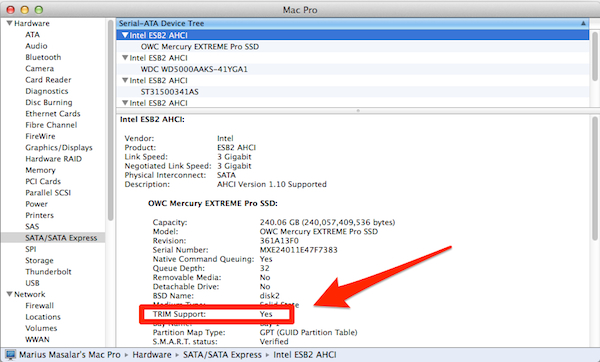
- CINDORI’S TRIM ENABLER MAC OS X
- CINDORI’S TRIM ENABLER INSTALL
- CINDORI’S TRIM ENABLER SOFTWARE
- CINDORI’S TRIM ENABLER FREE
I have yet to see any reports that external SSDs in APFS format need TRIM to be enabled because write performance has deteriorated, although the default in macOS appears to be to disable TRIM support for external SSDs. In practice, it shouldn’t be hard to detect poor write performance on an SSD which could be addressed by enabling TRIM. In early releases of APFS, users who manually enabled TRIM sometimes encountered longer boot times, which have been attributed to TRIM commands being sent to the SSD during the boot process.
CINDORI’S TRIM ENABLER SOFTWARE
While generally available for software RAID systems, except AppleRAID, the TRIM command is normally not supported by hardware RAID systems.Įnabling TRIM doesn’t automatically improve performance, and in some circumstances can instead impair performance. Operating systems, including macOS, gained TRIM support around 2010, but this has proved quite complex and varied by type of SSD, and by file system.
CINDORI’S TRIM ENABLER FREE
This allows the SSD controller to erase that block, and maintains good write performance even under heavy use with limited free space.

To avoid incurring such overhead, the operating system can maintain a list of blocks which are no longer in use, and once a block becomes unused, it can inform the SSD’s firmware that the block can now be re-used. This is commonly addressed by relocating any other retained data within the block, so enabling that block to be erased ready to receive the new data. This is complicated by the fact that data is written in pages of 4-16 kB, but erase commands always affect complete blocks, which typically consist of 128-512 pages. However, before NAND flash memory cells used in SSDs can be re-used for writing, their contents must be erased, a process which makes writing to them significantly slower. When re-using those blocks for new files only requires that they are rewritten, as on a hard disk, that’s not a problem, as the disk controller can choose to reuse them whenever it wants without any side effects. On any storage medium, the file system normally deletes files by marking their storage blocks as being no longer in use. This isn’t an abbreviation, but refers to the TRIM command, which is central to this issue.
CINDORI’S TRIM ENABLER MAC OS X
To re-enable the Sudden Motion Sensor in Mac OS X 10.With many Mac users switching from hard disk storage to SSDs, and following my recent article about adding a two-SSD external enclosure, I thought it might be useful to look at some commonly-raised issues about SSDs: TRIM, wear levelling, and how they interact (or don’t) with macOS, particularly APFS. To disable the Sudden Motion Sensor in Mac OS X v10.4 and later: $ sudo pmset -a sms 0 This is to prepare for the HDD, the purpose is to shut down the hard drive when the notebook to vibration monitoring to protect the data, for the SSD, this is not required.
CINDORI’S TRIM ENABLER INSTALL
If you install the SSD in the HDD hard drive location, you can turn off hard disks sensor. Mac notebooks: About the Sudden Motion Sensor If the system is found to be unstable, then re-open the virtual memory: $ sudo launchctl load -w /System/Library/LaunchDaemons/_ist

$ sudo launchctl unload -w /System/Library/LaunchDaemons/_ist Vm.swapusage: total = 512.00M used = 0.00M free = 512.00M (encrypted)Īfter closing the virtual memory system that retains those used for virtual memory swap file can be deleted. View the virtual memory currently in use: $ sysctl vm.swapusage Turn off the system swap can also improve performance. Ars Technica points out that running TRIM prompts a "scary" message from the system, but notes it's largely because each SSD implements TRIM in a different way, with older disks sometimes acting in a way OS X would not expect.Īdvised to turn off the system's virtual memory (Swap), avoid frequent writes.
To enable TRIM, a user just has to type sudo trimforce enable into the Terminal window. This means that Mac users looking to install an after-market SSD in a machine originally intended for spinning disc hard drives would run into trouble without the help of other third-party tools. Most modern operating systems support TRIM but for Apple's OS X, it has only included support for its OEM SSDs.

In the absence of TRIM, users can see significantly slower drive writes as the drive begins to fill up. TRIM is a system-level command that allows the operating system and the drive to communicate about which areas of the drive are considered unused and thus ready to be erased and rewritten to. Called trimforce, the utility can be executed from the OS X terminal, and it requires a reboot to start working. OS X 10.10.4 Supports TRIM for Third-Party SSD Hard Drives. With the flip of a switch you can improve the speed and longevity of your Solid State Driveĭownload from Cindori Software Official Website /trimenabler Trim Enabler is the first and safest utility for enabling Trim in Mac OS X.


 0 kommentar(er)
0 kommentar(er)
